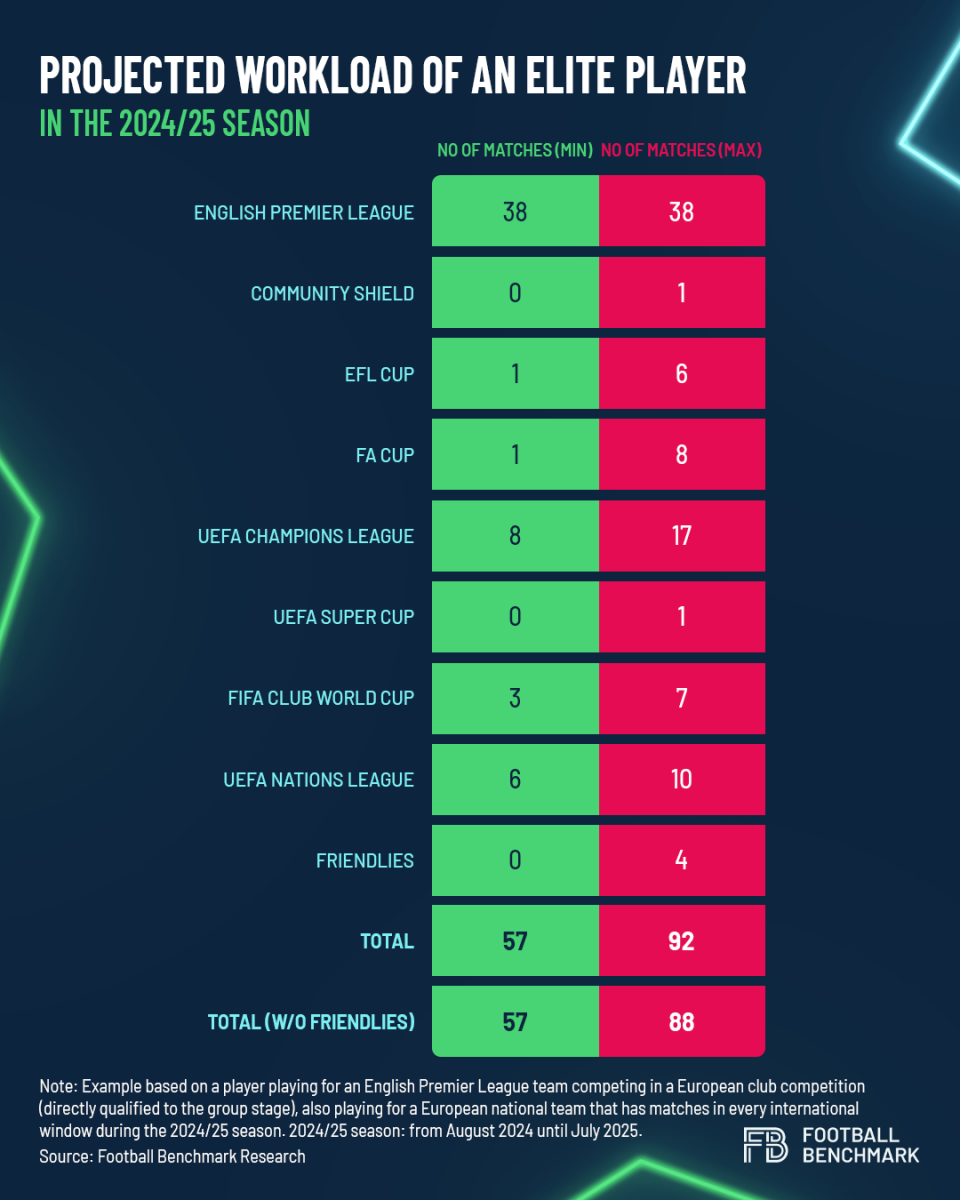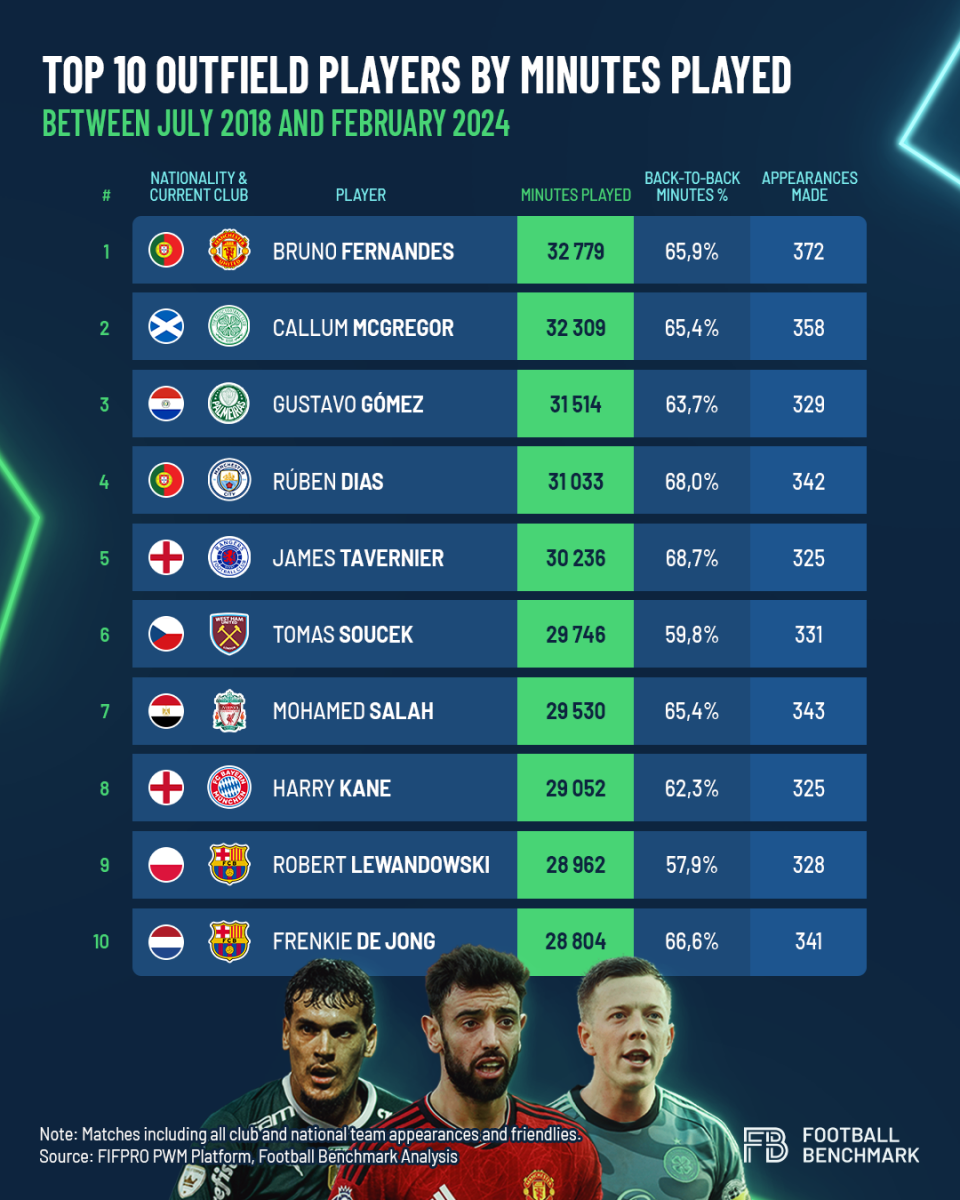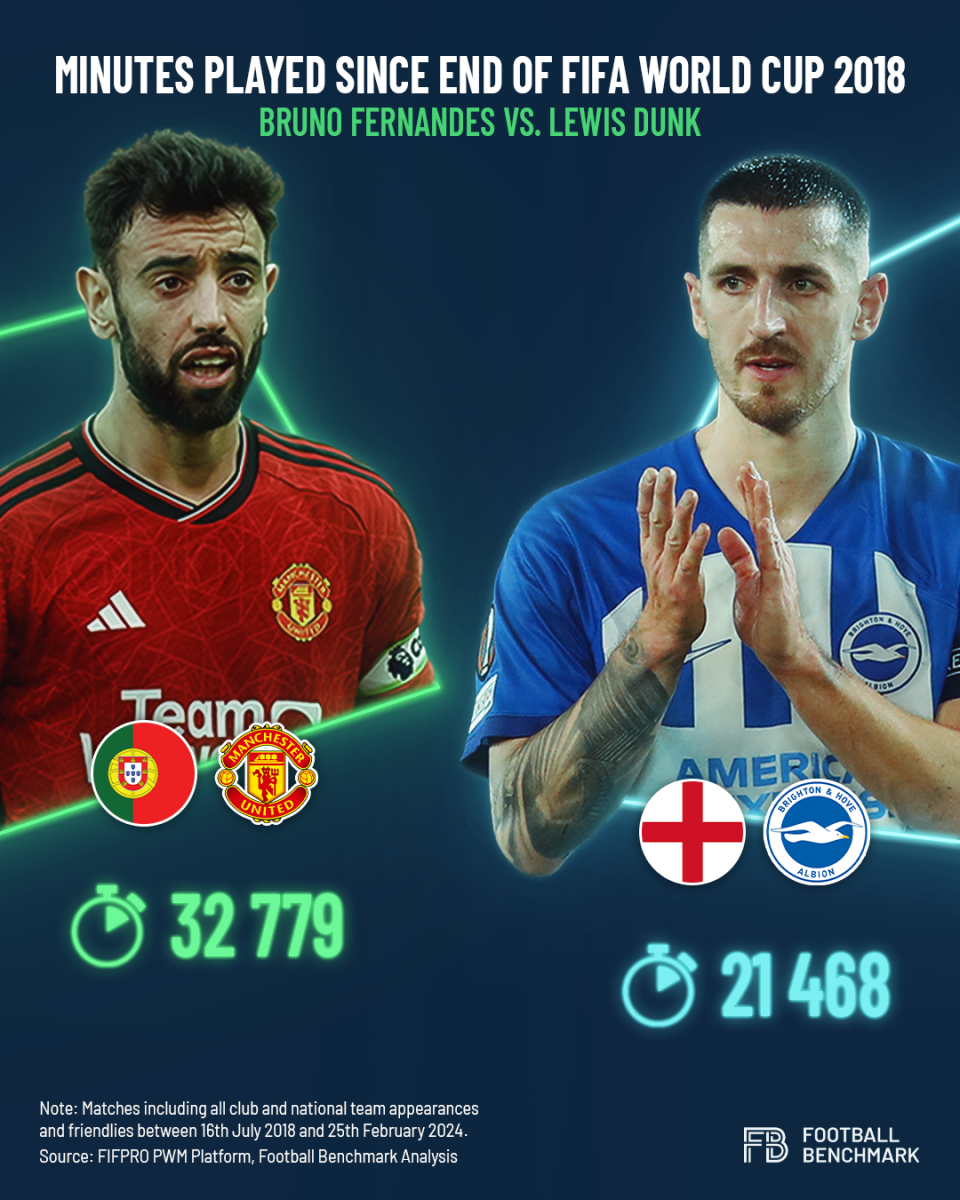Perhaps one of the most debated topics in football among experts, players, and fans alike currently is the increasing number of matches. The 2024/25 season promises to be especially important in this regard, with the new format of UEFA club competitions, the revamped FIFA Club World Cup, and events such as UEFA EURO 2024, Copa América 2024, Olympics Games Paris 2024 and the Africa Cup of Nations 2025 all contributing to an incredibly packed match calendar for players. Let's examine what a player's season might look like during the 2024/25 period and what challenges it might present for teams.
Check out the latest episode of Sky Football Benchmark about the extreme calendar congestion.
Are 90-match seasons on the horizon?
First, let's delve into an analysis of Manchester City's extremely successful campaign, to understand the workload of a club that competed on many fronts and ended up winning a historic treble. In 2022/23, the “Citizens” triumphed in the English Premier League, the FA Cup, and the UEFA Champions League. In addition, they also reached the quarterfinals of the Carabao Cup and participated in the Community Shield. Additionally, they engaged in two friendly matches in the USA in 2022 as part of their preseason endeavours.
Consequently, the club played a total of 63 matches during this period.
Considering that most of the club's players received call-ups to their respective national teams, it's likely that for many of them, the appearance count exceeded 70 last season (assuming they maintained fitness and availability for selection).
But what lies ahead from the 2024/2025 season onwards regarding the potential number of matches? Let's consider the scenario of a European national team player from an English Premier League club participating in the UEFA Champions League. For the sake of the argument, let’s assume their club will also compete at the 2025 FIFA Club World Cup. We consider the minimum and maximum number of matches depending on the player’s teams’ progress in various competitions.

Taking the team's obligations in England into account, we can expect a guaranteed 38 matches in the English Premier League, at least one in the FA Cup, and at least one in the EFL Cup. Following the introduction of the UEFA Champions League’s new format, we anticipate a guaranteed 8 matches in the league stage, and for the FIFA Club World Cup, there will be at least 3 matches. Additionally, there will be 6 national team matches in the UEFA Nations League.
So far, the player stands at a total of 57 matches. Let's see how this number evolves if his teams perform well and progress to the finals of each competition.
In England, at the most extreme, alongside the 38 league matches, the player will participate in 8 FA Cup and 6 EFL Cup encounters (assuming two replays in the FA Cup 3rd and 4th rounds). In the UEFA Champions League, the player will engage in a total of 17 matches (assuming that their team does not qualify directly to the round of 16 from the group stage and thus have to play in the knock-out round playoffs). Considering the maximum 7 matches from the FIFA Club World Cup and the 10 matches from the UEFA Nations League, we reach a theoretical total of 86 matches.
Suppose the club in question performed admirably in the 2023/24 season, they will also participate in the Community Shield and UEFA Super Cup matches. Then we are looking at 88 matches.
If we further consider that clubs play friendly games at the beginning of the season, assuming an average of 4 matches, we reach a total of 92.
Therefore, in the 2024/25 season, a player could potentially play up to 92 matches. This equates to a potential appearance every 3.9 days over the course of 365 days.
While it is highly unlikely that a player would be available for all 92, this example still illustrates the extreme workload put on elite players of today. A calendar like this could apply next season to several players from clubs like Manchester City including Rúben Dias, Kevin de Bruyne or Phil Foden.

It's worth noting that the 2023/24 season alone constitutes a lengthy period in football, given the array of international tournaments taking place during this time, such as the Africa Cup of Nations, the AFC Asian Cup, and upcoming events like UEFA EURO 2024, Copa América 2024, and the 2024 Paris Olympics.
In light of this, the question arises: How will football clubs cope with such an extensive workload?
Will clubs participating in UEFA competitions endure greater challenges?
Taking the current situation of teams like Real Madrid CF or Liverpool FC as an example, where key players this season had to be sidelined due to a notably high number of injuries - often resulting in the promotion of youth players from their academies - raises further concerns with even more games to come next season. How will clubs assemble their squads to remain competitive on all fronts, and how will this impact the evolution of staff costs? These questions are expected to be answered by the clubs themselves in the upcoming summer transfer market.
Until then, in the following, we compare the past six seasons of Liverpool and Real Madrid with those of other clubs from their domestic leagues – Everton FC and Getafe CF – that do not play as often in European club competitions.
Since the start of the 2018/2019 season, both Liverpool and Real Madrid have participated in UEFA competitions every year: Real Madrid have been a consistent participant in the Champions League, while Liverpool have appeared in the Champions League for the past 5 seasons and is currently competing in the Europa League this year. Moreover, the clubs faced each other in the final of the 2021/2022 Champions League.
If we add up all competitive matches since the 2018/2019 season, including the remaining ones for this season, we see that the English club will have played 336 matches during this period, while the Spanish club will have played 329. In both cases, there could be an additional 3 matches if they reach the finals of the Champions League or the Europa League.
.png)
Examining the same period, we observe that Everton played 261 matches, while Getafe played 256. The lower figures compared to Liverpool and Real Madrid are clearly attributed to the absence of consistent participation in UEFA competitions. During the period under review, Everton did not participate in any UEFA tournaments, whereas Getafe played a total of 9 Europa League matches.
Aside from the number of matches, it's worth discussing the aspect of travel and the burden of back-to-back matches. While players from Everton and Getafe played almost 100% of their matches domestically, players from Liverpool and Real Madrid travelled abroad for international fixtures, thus reducing the time available for recovery. Back-to-back matches refer to situations where there is less than a 120-hour gap between the end of one match appearance and the start of another.
It's therefore clear that the clubs participating in UEFA competitions have faced significant workload challenges thus far, but from the next season onwards, they will face an even greater burden, and so will the players.
How will a congested calendar affect an elite player?
Continuous fielding of key players is essential for most teams to achieve success, yet injuries and suspensions can hinder players from maintaining peak form and consistency. Based on the period between July 16, 2018 (end of FIFA World Cup 2018), and February 25, 2024, here's how the top 10 outfield players with the most minutes played look like:

Bruno Fernandes is virtually “indestructible”, having played a total of 372 matches and 32,779 minutes during the analyzed period, with 65.9% of those minutes being played back-to-back. For comparison, Frenkie de Jong, who holds the 10th position on the list, played 31 matches and 3,975 minutes less than the Portuguese midfielder.
Fernandes can consider himself somewhat fortunate to have avoided injuries throughout his career, despite appearing in almost every match for both his clubs and the Portuguese national team. Few top players can claim such durability under strain, as injuries of varying degrees are common with such a workload. However, Fernandes' exceptional endurance and match history serve as a prime example of the workload faced by top players who compete in both international and domestic competitions. To put this into context, we compared Manchester United's captain with Brighton and Hove Albion's Lewis Dunk. The English centre-back was selected as the counterpoint because he also plays in the English Premier League, serves as a captain for his team, and has similar domestic football commitments but fewer international club and national team duties compared to Fernandes.

There is a difference of over 10,000 minutes in playing time between the two players during the analyzed period. Both players competed in the English Premier League during this time, but United's player also participated in European competitions (UCL, UEL) and represented the Portuguese national team, missing only 3 matches due to injury. In contrast, Dunk was forced to miss 12 matches due to injuries since 2018, played only 7 matches in the UEFA Europa League, and has a total of 3 senior international caps.
In summary, the international football calendar for the 2024/25 season is set to push players to their absolute limit, presenting a formidable challenge for clubs as they prepare their squads during the transfer window and strive to maintain the fitness of their players throughout the demanding season. Moreover, clubs must navigate these challenges while ensuring compliance with the UEFA Financial Sustainability regulations and the club licensing regulations set by national leagues.
Enjoyed what you read? For more workload insights, check out the Player Workload Monitoring Tool developed jointly by FIFPRO and Football Benchmark here.



